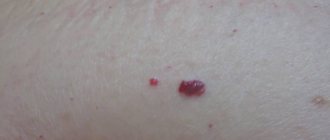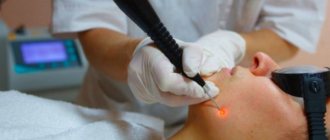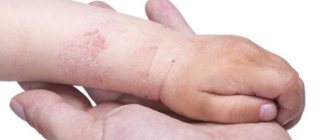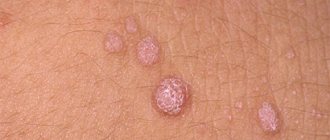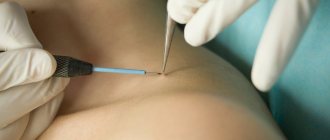Ugly skin growths suddenly appear in the most unexpected places and force a person to feel embarrassed about his body. Cauterization of papillomas gives a good result, helping to quickly cleanse the skin of ugly growths and restore its smoothness. Timely elimination of papillomas will prevent their growth and degeneration into a malignant tumor. As soon as possible, you need to get rid of growths that are constantly injured by clothing and jewelry. All papillomas in intimate places, as well as tumors with a high probability of degeneration, are subject to mandatory removal.
Should I delete
Few patients are sure that they need cauterization of a skin growth caused by HPV activation. In fact, doctors do not recommend such treatment in all cases. They often diagnose very small papillomas that do not cause any discomfort. It's best not to touch them. The situation is different with tumors that are constantly injured or have a tendency to degenerate into a cancerous tumor. Such growths must be removed immediately after detection.
The attending physician can tell you exactly whether papillomas need to be removed by cauterization or not.
A dermatologist will determine how to remove papillomas and whether it needs to be done
Reviews and cost of removing papillomas with liquid nitrogen
There is no pain after a cryotherapy session, rapid rejection of non-viable tissue - about 8-9 days. Patients who have gotten rid of clusters of filament-type tumors respond positively to the technique: the treatment time for each growth is 3–6 seconds, the redness disappears quickly, and there is no pain at all. For more significant skin damage, a repeat procedure is required.
The cost of papilloma removal depends on how cryodestruction is carried out: manual processing is cheaper than hardware. The main factor influencing the price is the type of papilloma and its location. Depending on the clinic, the cost varies from 100 to 800 rubles. for one knot.
If the technique is fully followed, cryotherapy is safe and does not cause complications. It is important to follow your doctor's recommendations regarding home treatment and care after papilloma removal.
At home
Many people prefer to remove papillomas at home. Before starting a treatment course, you must obtain permission from your doctor for these actions. He will tell you which drugs and products are best to use to achieve the desired result.
Iodine
Cauterization of papilloma can be done with iodine. It is intended for application to the entire surface of the problematic growth and its stem, if any. The procedure is repeated about 2 times a day. After about a couple of weeks, signs of the death of the papilloma will be noticed.
Doctors allow cauterization of papilloma with pharmaceutical iodine only after confirming its benignity. They also recommend using this method only for single growths.
Plant juice
The juices of certain medicinal plants will be useful in the treatment of problematic neoplasms that have appeared in people infected with the human papilloma virus. Traditional healers advise using such defects on the skin:
- Celandine juice;
- Aloe juice.
Cauterization of papillomas with aloe juice or celandine is carried out according to the same scheme. A benign neoplasm must be regularly lubricated with the juice of a medicinal plant. Compresses made from their leaves are also useful.
Celandine effectively removes growths, but you need to remember its toxicity
Hydrogen peroxide
Everyone should have hydrogen peroxide in their first aid kit. This proven remedy is useful in the treatment of viral skin rashes. You can use the liquid in the fight against papillomas in the following way. It is enough to simply apply 3% peroxide to the tumor. After some time, it will begin to dry out and fall off. As a rule, the entire treatment takes no more than 2 weeks.
Hydrogen peroxide is also used to make therapeutic compresses. The gauze is well moistened in pharmaceutical liquid, after which it is securely fixed with an adhesive plaster on the papilloma. The compress must be changed every 2 hours. In just 3 days the growth should disappear.
The same principle is used to cauterize growths with potassium permanganate, or rather with a 5% solution.
Soap
To eliminate papillomas, laundry soap is often used. It replaces many expensive drugs. To achieve the desired result, you need to rub the growth with a thick layer of soap before going to bed for several days. Do not rub too hard, as this can damage the viral tumor. After a while, the papilloma will simply fall off.
A home remedy for cauterizing problematic papillomas only helps to get rid of a specific growth, and not to destroy the virus. It will still remain in the human body and be activated when favorable conditions exist.
Soap will get rid of papilloma, but not the virus
Which doctor should I contact?
The appearance of vegetations on the genitals is accompanied by other bacterial diseases, inflammatory processes in the reproductive sphere, and an imbalance of pathogenic, opportunistic flora. You should undergo a comprehensive examination.
Condylomatosis is treated by a gynecologist in women, a urologist, andrologist or dermatovenerologist in men.
A comprehensive examination includes:
- smears from the urogenital tract;
- examination, colpocoscopy in women;
- PCR analysis to confirm the fact of infection with papillomavirus, determine the type of HPV and its oncogenicity, and the viral load on the body;
- according to indications - general urine and blood tests, in men - prostate secretions;
- diagnostic instrumental examination methods - ultrasound, TRUS, CT - are indicated if the presence of malignant formations or secondary tumors is suspected.
Treatment is carried out on an outpatient basis. The exception is flat condylomas on the cervix in the presence of a cancerous tumor.
In this case, the woman will be referred for a consultation with a gynecologist-oncologist to determine further tactics for managing the patient. Drug therapy is indicated for both partners.
Cauterization methods
Modern cauterization methods allow you to get rid of single or multiple papillomas quickly and painlessly. They can only be prescribed by specialists.
Chemical method
For papillomavirus, a chemical method of cauterizing skin growths on the body is often prescribed. For these purposes, specialized preparations are used that differ in acid or alkali content. The most popular means suitable for chemical cauterization are:
- "Collomac". The drug contains lactic and salicylic acids. It must be applied directly to the affected area. The procedure is carried out for several days in a row. The medicinal composition will cause necrosis of papilloma tissue, due to which it will disappear painlessly;
- "Super Clean". The cauterizing drug is based on sodium hydroxide alkali. The substance causes a chemical burn in the area where it was applied. The ointment also contains salt and soda, which slightly soften the aggressive effect of the active component of the drug. It is highly not recommended to use this medicine to treat papillomas on the face or mucous membranes;
- "Dermavit". Another famous drug that basically contains sodium hydroxide. It copes well with benign tumors;
- "Podophyllin." A medicine that differs from its analogues in its plant base. It is ideal for treating growths in intimate places, as it has a milder effect than the above drugs.
Chemical therapy makes it possible to quickly get rid of problematic growths. When used correctly, no trace remains of papilloma after cauterization.
Medications for the safe removal of papillomas should be prescribed by doctors. Spontaneous use of aggressive compounds can lead to serious burns on healthy skin. In addition, these actions are quite capable of provoking the degeneration of benign tissues into malignant ones.
Electrocoagulation
To carry out the procedure, a special device is required that acts as a generator of direct or alternating high-frequency electric current. The therapeutic effect on the growth is carried out using electrodes. They look like loops that are placed directly on the tumor. Its tissues are quickly destroyed under the influence of current, due to which the papilloma is easily separated from the skin.
The whole procedure takes a few minutes. After cauterization, a small burn remains at the site of the papilloma, which is covered with a crust. To disinfect and accelerate healing, the wound is treated with 5% potassium permanganate.
In rare cases, small scars remain on the skin after electrocoagulation. Upon completion of the procedure, the specialist can send the fallen off body of the papilloma for histological analysis to determine its benignity.
Scarring may remain, so it is important that the procedure is carried out by an experienced specialist.
This procedure is prohibited for people who have malignant tumors in the final stages of development. It is also advisable to avoid it for patients with impaired blood clotting.
Cryotherapy
During cryodestruction, liquid nitrogen is used. The substance affecting papilloma reaches 196 C. Such a low temperature instantly freezes extracellular and intracellular fluids, turning them into solid years. Due to this, the benign tumor is completely destroyed.
A cryotherapy session takes no more than 2 minutes. To carry out the procedure correctly, the doctor will need a special tip. It limits the actions of the device and forces it to act exclusively on the affected area.
There is no sensitivity at the treatment site. When removed, patients may feel a mild burning sensation as well as tingling. After a couple of hours, the skin in this area will begin to turn red. The appearance of edema cannot be ruled out. On the same day, a bubble filled with black or brownish liquid may appear at the site of the papilloma.
After a few days, the bubble bursts on its own, and the wound immediately becomes covered with a crust. By the time it is completely healed, it will fall off on its own. This process takes on average 2-4 weeks.
Cauterization of papillomas with liquid nitrogen is not recommended if there are the following contraindications:
- Diseases of the heart and blood vessels;
- Hemorrhagic diathesis;
- Pulmonary tuberculosis;
- Cancerous tumors;
- Individual intolerance to cold temperatures;
- Mental disorders.
If a person has such diseases, he should inform the specialist who offers cryotherapy.
Cryodestruction has contraindications
Laser therapy
Cauterization of papillomas with a laser is by far the best method for removing various tumors on the body. For these purposes, a device is used that emits electromagnetic waves. The radiation emanating from it is quickly absorbed by the liquid in the tissue of the growth. It heats up greatly and turns into steam, as a result of which the body of the tumor seems to burst from the inside. In this case, neighboring tissues are not affected.
Removal of papillomas using this method is carried out under local anesthesia. After the procedure, a solution or ointment must be applied to the wound, which has a disinfecting effect.
Complications may occur after treatment. Their appearance in most cases is due to the fact that the patient provides the wound with improper care. They also cannot be avoided if the procedure was performed on a person with the following violations:
- Diabetes;
- Hemophilia;
- Chronic diseases of internal organs;
- Inflammations on the skin;
- Tendency to keloid scars.
All these deviations are contraindications for laser therapy.
Side effects and consequences
Allergies
Cryodestruction is a safe and painless procedure, causing virtually no complications. Unpredictable consequences can occur on the drugs used for anesthesia and on the liquid nitrogen itself.
To prevent an allergic reaction from occurring, it is first necessary to test for allergenic substances.
Prolonged exposure to the sun often leads to the formation of hyperpigmentation of the skin - coloring the area darker than the rest of the skin surface. Avoiding ultraviolet radiation will help prevent this side reaction.
Cauterization of a tumor on the scalp is accompanied by the removal of hair follicles, which leads to local baldness.
Local baldness
If the bladder begins to fill with bloody contents, it is necessary to notify the attending physician - he will open the swelling and apply a sterile bandage.
Features of removal in intimate places
Very often, doctors strongly recommend that patients cauterize papillomas in intimate places. Growths in such a piquant area can greatly interfere with normal sexual intercourse and become a threat to the natural course of labor. Home treatment of such papillomas is prohibited, since for this diagnosis they are not only ineffective, but also dangerous.
If the patient is afraid of cauterization of papilloma in an intimate place, the doctor will prescribe surgical excision. This method is most successful in situations where a large area is affected by growths or a malignant course of the disease is diagnosed.
Burning papillomas on the genitals with home remedies is prohibited
Removal of papillomas with liquid nitrogen or cryodestruction?
Cryodestruction is performed by a specialist after a full examination and passing the necessary tests. The removal process lasts no more than 5 minutes, and it does not matter which method is chosen: manual or hardware. The hardware method uses a cryoprobe, but in most clinics and beauty salons, papillomas are removed manually using cotton wool on a stick.
Removal with liquid nitrogen takes place with preliminary anesthesia with lidocaine or novocaine. This is necessary in the following cases:
- If the patient is a child;
- For large growth sizes;
- If the nodules are located on sensitive skin.
The painkiller is absorbed into the skin for more than 10 minutes.
Contraindications
Each of the methods has a number of contraindications, which deprive the patient of the opportunity to cauterize the problematic papilloma in one way or another. Absolutely all hardware procedures that allow removal of a tumor are prohibited in the following conditions:
- Aggravated forms of chronic diseases;
- Pregnancy;
- Intolerance to certain treatments;
- Acute inflammatory processes.
Home methods are considered safer if we consider the contraindications of various treatment methods. This is because most of them are based on the use of natural products and ingredients.
How likely are complications?
The main negative consequence is associated with the inflammatory process, which inevitably accompanies all cosmetic and medical procedures. Most often, such a reaction is observed when hygiene standards and doctor’s instructions are not followed.
What are the complications associated with:
Possible complication:
Piercing postoperative blisters leads to tissue suppuration;- Self-removal of the scab prevents effective wound healing and provokes the formation of a rough scar;
- Intense friction during washing leads to the growth of the inflammatory process and additional trauma.
Cryotherapy is generally well tolerated by patients and is prescribed even to small children.
What it is
The cryodestruction procedure involves exposing skin growths to the destructive action of liquid nitrogen. This method is quite painful, but highly effective. In the recent past, it was permissible to remove papillomas using cold only in a medical facility. Now the situation has changed radically.
An alternative to this method is a drug called cryopharma for papillomas. Unlike the popular procedure, the procedure for freezing pathological tissues occurs as a result of the interaction of two active components - dimethyl ether and propane. The above ingredients provide exposure to cold temperatures down to – 57 degrees on neoplasms.
Cryopharma is a spray that is convenient to use for removing papillomas of various sizes and shapes. In addition to the canister, which is enough for at least twelve procedures, the kit for removing papillomas includes a holder with replaceable applicators designed for direct contact with the skin.
Pharmacy products
There are special pharmaceutical preparations for getting rid of papillomas, which can be bought in Moscow and other cities of the country:
Photo: wart removal liquids
- lapis pencil;
Photo: pencil for removing papillomas
Photo: acid-based products
Photo: application of Supercleaner
Photo: cauterization of growths with Cryopharma
